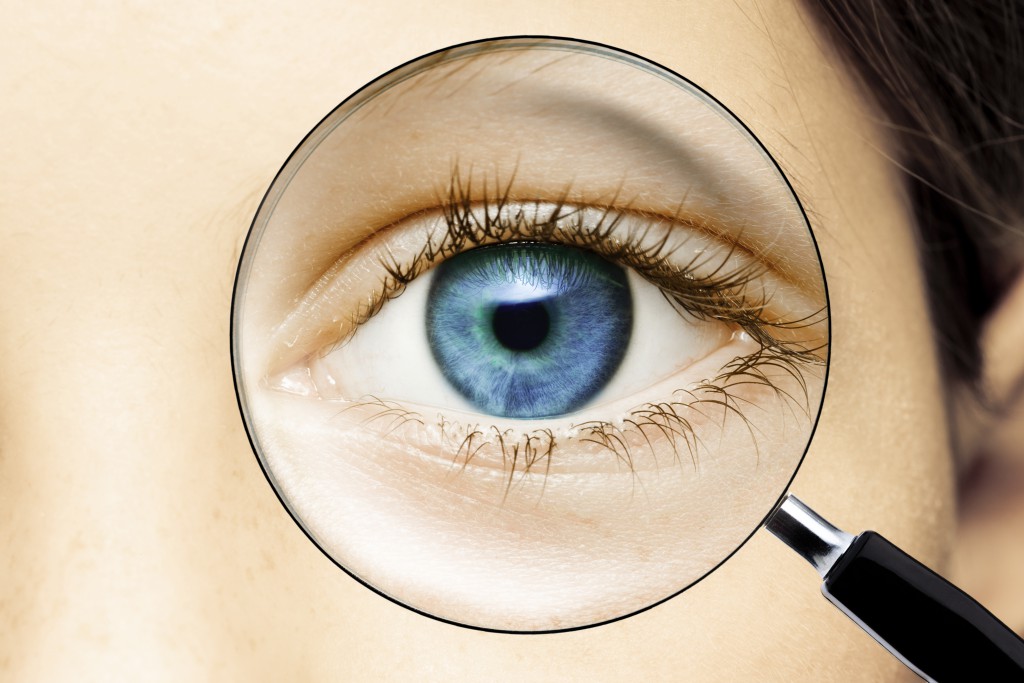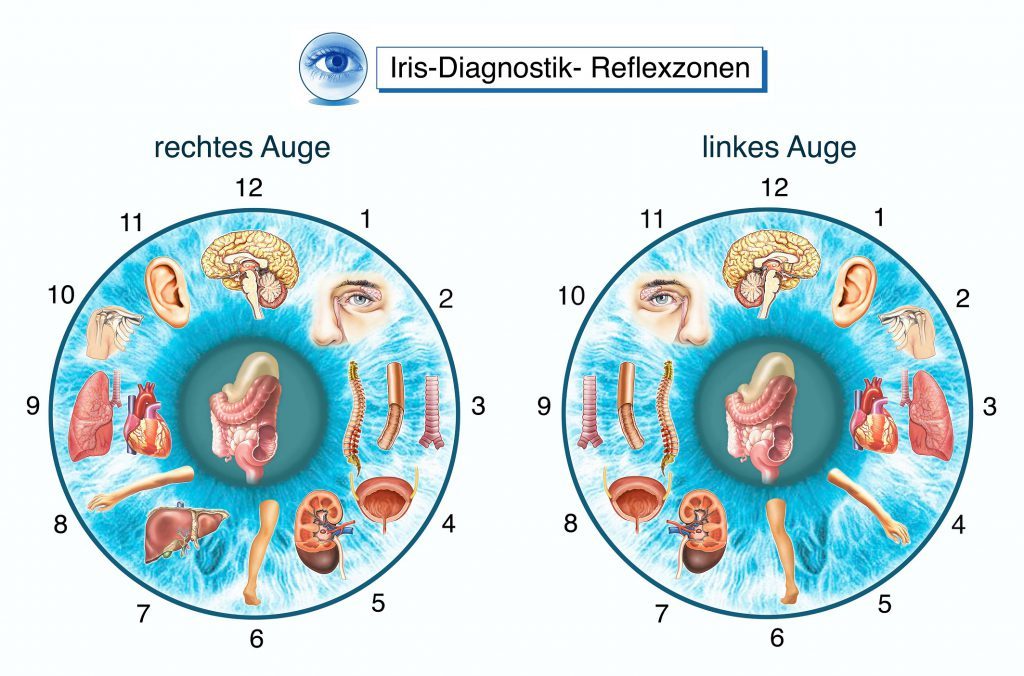
The iris diagnosis is an alternative medical diagnostic technology with thousand-year-old roots. Other common names for iris analysis, eye diagnosis, or iridology. With your help it should be possible for existing or recognize, in part, also, in the future, the threat of diseases of people on the basis of the iris of the eye (Iris). This is the colored area of the eye that surrounds the pupil is circular and can be tinted in various shades and mixtures of the colors Blue, grey, brown or Green.
Table of contents
At the time of iris diagnosis is considered to be enlarged with iris microscope or special magnifying glass the eye. For example on brown or black spots, a radiation-shaped pattern, turbidity, or other special features in the Iris is taken. Depending on which part of the rainbow, these phenomena of the skin occur, is to draw conclusions on the affected body region and the nature of the disease be possible. So far, however, there is no scientifically sound evidence for the success of this form of Diagnostics.

Origins and development
Already in ancient Egypt, the art of iris diagnostics have been applied. From Traditions, it is known that the Chaldeans should have has of Babylonia the Knowledge to identify diseases on the basis of the eyes. By the Fund earlier stone slabs in Asia, there are indications that people used there as well, the iris diagnosis. They employed, with particular attention to color changes in the eye.
Philippus Meyens divided in 1670 in Dresden, the Iris in different areas, and he assigned each to specific areas of the body. His findings, he wrote in the “Physiognomia Medica” and established the foundations for today’s iris diagnosis.
In the late nineteenth century, the Hungarian physician Ignaz von Péczély, an avid Falconer, dealt intensively with the iris diagnosis. One of his owls broke his leg. He discovered in the Iris of the injured owl, a black line that was exactly in the organ Association of the affected body part. This line has also remained after the recovery of the animal. That was for him the proof that in the Iris at certain Points in certain regions of the body are visible. The right half of the body was on the right Iris and the left half of the body on the left of the Iris is visible. In 1886, published by Ignaz von Péczély his findings.
Magdalene Madaus opened in the thirty years of the twentieth century, a teaching Institute of iris diagnosis in Dresden. Josef Deck, written in 1965, is a standard work on the iris diagnostics: “principles of iris diagnosis. Textbook with Atlas and therapy notes“. Continues to be involved intensively with this diagnosis, the form of the famous Pastor Emanuel Felke, Josef Angerer, Joachim Broy and Gunther Lindemann.
To date, the iris diagnosis is a controversial diagnosis form. Since there is as yet no scientifically sound evidence for their effectiveness, rates of physicians, most of the Eyes and eye doctors from the application of this form of therapy. The German ophthalmologic society was 2018 so far as to warn of the iris diagnosis. Many alternative practitioners and naturopaths, but also some School physicians and school physicians, have, however, made in the everyday practice of good experiences and to apply the method, therefore, nevertheless. And even the German ophthalmologic society acknowledges in the same article, that for some diseases, a very well-detectable changes of the rainbow occur skin: So, for example, nodules can go to the Iris with trisomy 21 (congenital chromosomal error), sarcoidosis (inflammatory connective tissue disorder characterized), or neurofibromatosis (a tumor disorder).
As with many other alternative medical therapies or diagnostic methods, also applies here: The Lack of scientific effectiveness means evidence automatically, that a therapy or diagnostic form is actually invalid. A responsible therapist or a responsible therapist will let a serious diagnosis, but always by other methods to confirm and to safety on a school medical clarification. Also, as a Patient, you should not be afraid to ask for a second opinion. Your doctor or your attending Physician advises you with all the questions.
Basics
The Cornea (cornea) of the eye is transparent. Thus, the therapist or the therapist can look at the translucent Iris. The Heidelberg physician, Dr. Walter Lang has been demonstrated in the middle of the twentieth century, all regions of the body are connected through nerves with the eye. Therefore, can show up in the view of the iris diagnosis and diagnosticians in the Iris diseases and disorders of the organs. Thus the rainbow can serve the skin as a diagnostic Medium, with the genetic predispositions, contaminated zones and the particular vulnerabilities of the body to discover. Also for prevention of the eyes is used to diagnosis, since many of the changes in advance.
In the case of the method of iris diagnosis is a reflection of all the organs in specific zones of the Iris: the Right location, the organs of the body will be reflected accordingly in the right Iris, the left location, the organs of the body in the left Iris, internal organs in the vicinity of the pupil and the more outwardly located the organs at the periphery of the Iris.

Circular division of the Iris
From the pupil to the edge of the Iris is divided into three large or six small zones.
So the first major Zone contains, from the inside of the eye, the stomach and intestines. Changes, here to be perceived, point to digestive disorders such as problems of food utilization, and the like. This Zone is also referred to as “Krause zone”.
The next Zone, which connects to the gastro-intestinal zones, contains bladder, blood, lymph, heart, kidney, pancreas, and gallbladder. Here also change in terms of the fuel transportation and recycling are seen.
The third major Zone, which is adjacent to the iris edge, reflects the liver, spleen, nose, mouth, urethra and Anus. The second and third Zone are collectively called the “Ziliarzone”.
The six small zones of the Iris to the edge, following the stomach zone, the intestinal zone, the blood-lymphatic zone, muscle zone bone zone and skin region named:.
Within the zones is again divided into sectors, so that according to the principle can be associated with reflection on the basis of the position of an optical abnormality in the Iris, which Organ or System in the body may be disturbed or vulnerable.
The exact distribution of the Iris is different, in part, for different Theorists and theorists who have shaped this form of Diagnostics.
Iris signs
The practitioner or the Practitioner makes use of an iris microscope or an Iris lens to the eye increases to see. So even the smallest changes in color, veil, stains and the like can be made visible.
Reflector Characters
Reflective signs can indicate acute or recurrent inflammation. This comment on the rainbow skin in the Form of so-called transversal. Transversal denote the Radial (rays), which deviate from their normal direction; usually, they are arranged like wheel spokes. Vascular malformations are possible. These are small blood vessels that accompany the Radial.
Body characters
So-called organic signs on the basis of the theory of iris diagnosis to impaired organ function. They show, for example, in the Form of crypts (“trenches” in the Form of a Rhombus), lacunae (oval-shaped “cavities”), or a single or several honeycomb-shaped Structure.
Crypts may occur, especially in the case of serious diseases, such as, for example, of the back, or bone marrow. On the Iris in a crypt as a crater is visible, you can see in the Dark rainbow skin.
Lacunae are either open or closed. An open lacuna, which is supposed to indicate according to the Teachings of the iris diagnosis on an evolving disease process, for example in the Form of a Tulip. A closed lacuna may rather point to a manifest, i.e. a pre-existing disease.
Physiological Signs
Physiological signs may indicate a strain on the metabolism (metabolism). This can show, for example, in the Form of so-called “Tophi”, which means as much as “flakes”. Also, pigment deposits can display a metabolic disorder.
Constitutional types
Constitutional types are actually innate. However, various factors can affect in the life of the plant positively or negatively. So a mixed type over the years in one direction or the other. These types of Constitution, according to the theory of iris diagnosis on the basis of the rainbow of human skin. Each constitutional type, therefore, describes a specific hereditary predisposition.
There are three major constitutional types are distinguished from each other: The lymphatic Constitution, the hematogenous Constitution and the dyskratische Constitution. All three forms are then broken down in more detail below, and certain diathesis forms associated with it. Diathesis refers to the tendency of the body to certain diseases and is also used in part with the concept of responsiveness as a synonym.

So people with lymphatic Constitution are, according to this theory, blue-eyed, often suffer from diseases of the lymphatic system such as, for example, tonsillitis, recurrent ear infections, colds and the like. Most of their diseases are associated with fever.
People with been Constitution have, in theory, brown eyes, and more prone to suffer from diseases of the circulatory organs as well as spasms (cramps), and Hyperexcitability.
The dyskratische Constitution is a mixed form and is, according to the principles of iris diagnosis in connection with diseases of the liver, bile, pancreas and intestines.
Note: A diagnosis that was exclusively made with the help of iris diagnosis, you should confirm as a precaution, school, medical, or. (sw; kh)
Sources:
- Beer, Bach, Elvira (Hrsg.): Natural healing in practice today. Textbook and Atlas. Elsevier GmbH, Urban & Fischer Verlag, München, 4. Edition 2009.
- https://www.aerzteblatt.de/nachrichten/97971/Augenaerzte-warnen-vor-sogenannter-Irisdiagnostik